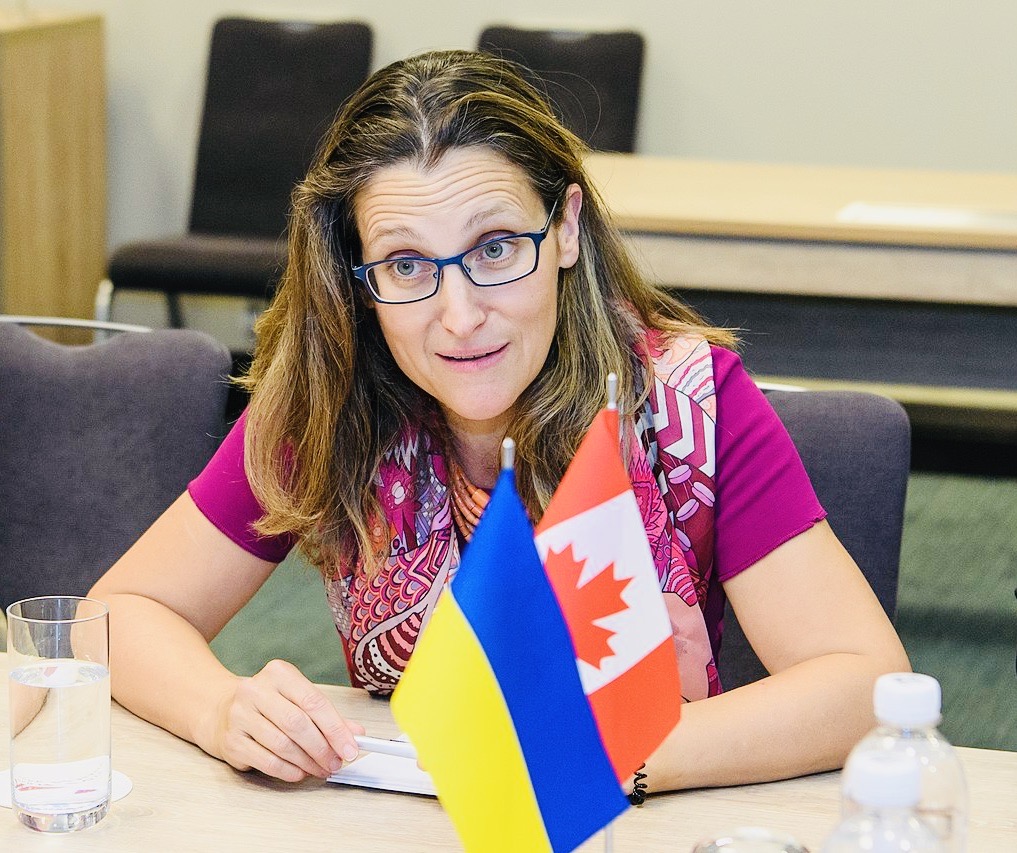Chrystia Freeland, Canada’s deputy prime minister and finance minister, attended a pro-Ukrainian rally in Toronto last Sunday. Amid a substantial crowd of demonstrators protesting Russia’s invasion of Ukraine, she stood between two people holding a red and black scarf bearing the slogan of “Slava Ukraini” (Glory to Ukraine).
A photograph of Freeland — an ethnic Ukrainian and an ardent backer of Ukrainian independence — was soon posted on her social media accounts. At first glance, it seemed innocuous. What could be amiss with Freeland’s appearance at a demonstration in support of Ukraine’s sovereignty and in opposition to Russia’s aggression?
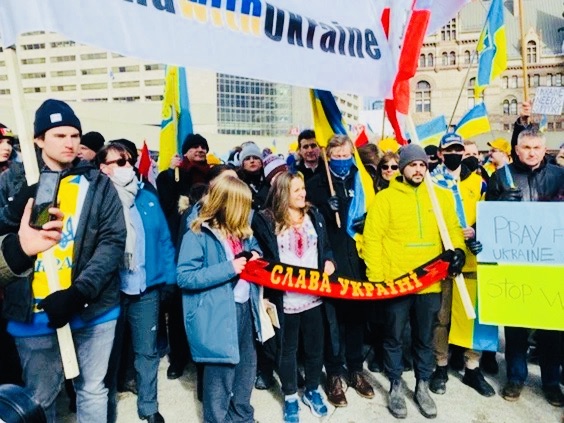
As we all know, appearances can be deceiving.
Shortly afterward, the photograph was inexplicably yanked from her social media accounts and replaced with another one without the red and black scarf.
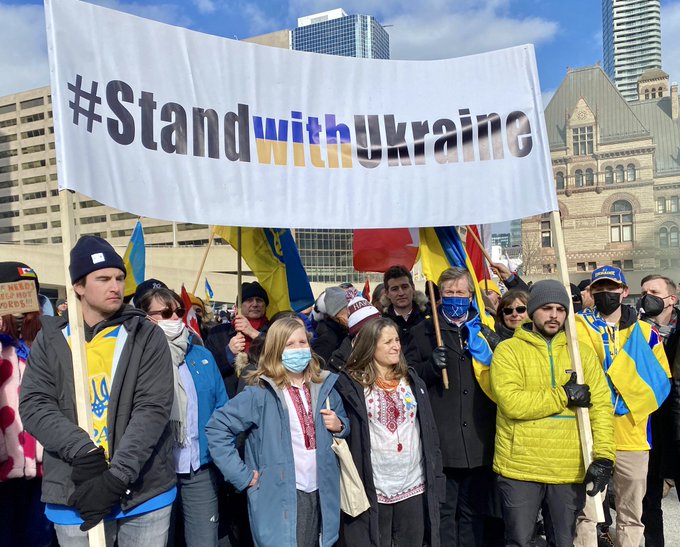
Freeland was embarrassed by the photograph because its colors in historical context symbolize racial hatred today. During the early 1940s, red and black were the proud colors of the Ukrainian Insurgent Army (UPA), the armed wing of the Organization of Ukrainian Nationalists (OUN), a breakaway faction of which was under the leadership of the notorious Stepan Bandera.
A hero in right-wing Ukrainian circles, he was an antisemitic nationalist who worked for Ukrainian statehood during Nazi Germany’s occupation of Poland and the Soviet Union. In collaboration with the Nazis, OUN rounded up Ukrainian Jews destined to be murdered en masse. In some instances, OUN foot soldiers killed them in genocidal rampages. These murderous incidents, which have blackened an era of Ukrainian history, have been meticulously documented by reputable historians.
According to Freeland’s press secretary, Adrienne Vaupshas, an unidentified person thrust the red and black scarf at Freeland and the people flanking her at the rally. Being very familiar with Ukrainian symbolism, she must have immediately noticed the colors of the scarf. But in what appears to have been a serious lapse of judgment, she did not remove the scarf from the scene. Only later did she realize she had committed a faux pas.
To avert a public relations disaster, Freeland instructed Vaupshas to issue a damage-control statement disassociating herself from Ukrainian extremists past and present: “We condemn all far-right and extremist views and organizations, whether they are in Russia, Ukraine or Canada. The deputy prime minister has no association with any far-right organizations.”
Obviously, Freeland feared that the photograph could damage her political career and could be used as a distraction by pro-Russian partisans to smear her as a right-wing Ukrainian nationalist in sympathy with Ukrainians like Bandera. At a time when Ukraine is existentially in peril, this would have been an awful moment for Freeland to have been tarred with that tag.
To be fair, the red and black colors predate Nazi-tainted Ukrainians like Bandera. Natalia Khanenko-Friesen, the director of the Canadian Institute of Ukrainian Studies, told the National Post newspaper yesterday that red and black banners are visible in 17th century Ukrainian paintings.
This argument, though valid, is rooted in shallow ground.
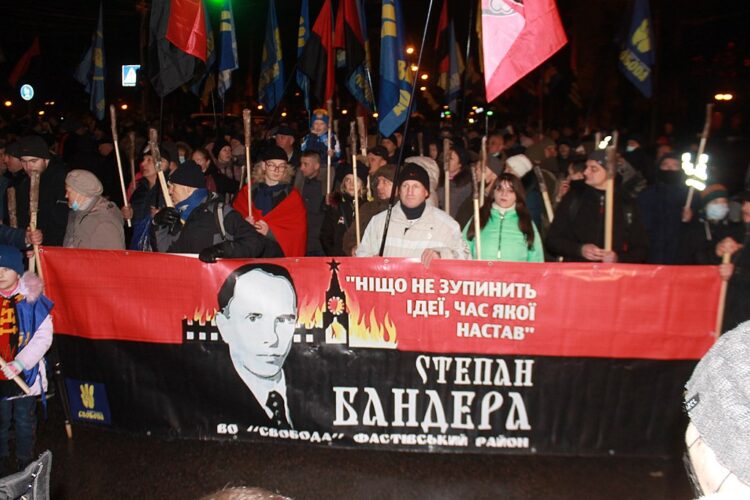
Since the Bandera faction of OUN appropriated these colors, and since they are regularly flaunted at torchlit parades in Ukrainian cities, Freeland should have known better than to pose with such an offensive scarf. She should have instantly realized that it could be used by Russia in its unrelenting disinformation campaign against Ukraine.
We should not dance around the fact that the red and black scarf symbolically reeks of genocide. It attests to the mass murder of Jews in Ukraine during the Holocaust. And it perpetuates Vladimir Putin’s absurd contention that one of the objectives of his invasion was to “deNazify” the country.
Consider this as well. The swastika, an ancient Hindu symbol of spirituality and divinity, was ruthlessly hijacked by the Nazis. But do contemporary politicians in India pose with the swastika? Definitely not. Since they understand that it was hideously misused by Adolf Hitler for his own evil ends, they keep the swastika at bay.
Freeland, a critic of Russia’s 2014 annexation of Crimea who called for Western sanctions against Moscow, seems to suffer from myopia. She could benefit from a lesson in optics.
Five years ago, when she was foreign minister, she remained unabashedly silent when pro-Russian websites accused her late maternal grandfather, Michael Chomiak, of being a pro-Nazi propagandist.
Chomiak (1905-1984), a Ukrainian nationalist, worked for the Nazi occupation authorities in Krakow and Vienna in his capacity as editor of Kravivski Visti, a Ukrainian newspaper that Canadian historian John-Paul Himka has labelled as “vehemently antisemitic.”
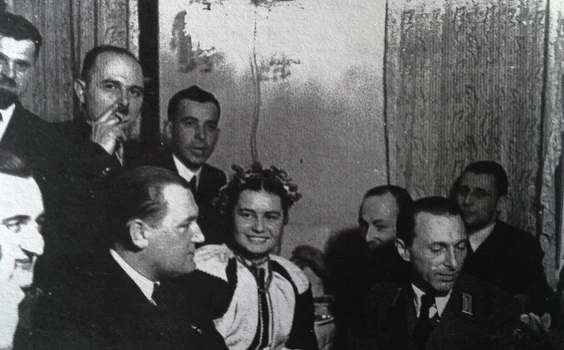
This rag published inflammatory articles that whipped up hatred against Jews and contributed to the animus that demonized and marginalized them in their deepest hour of duress and danger. Yet Chomiak did not have to pay a penalty for his association with the Nazi regime. In 1948, he and his family immigrated to Canada, where he died in peace.
Instead of coming to terms with her grandfather’s unsavory record, Freeland shamelessly characterized his unmasking as a Nazi operative as part of a larger Russian scheme to discredit Ukraine and Ukrainian nationalism and destabilize Western democracies.
It is still not too late for Freeland to speak to the truth and condemn her grandfather’s role in the Holocaust.
Sadly, much to her discredit, she prefers to whitewash him as a loving person and a decent and upright Ukrainian nationalist who fought for Ukraine’s dignity and independence and who led an exemplary life as a family man in Canada.
